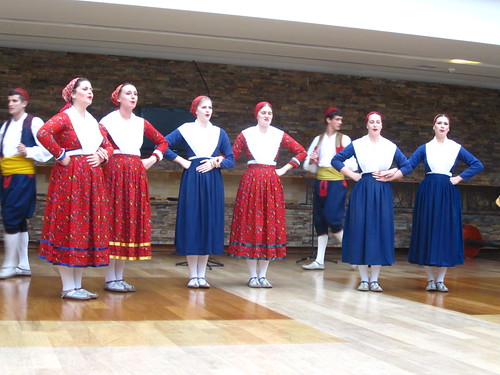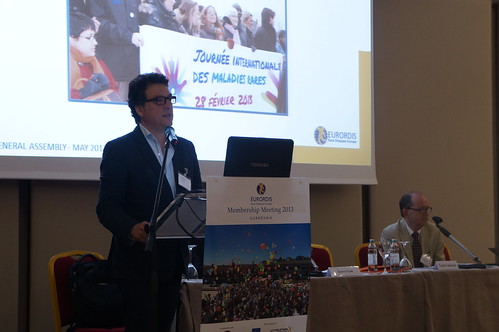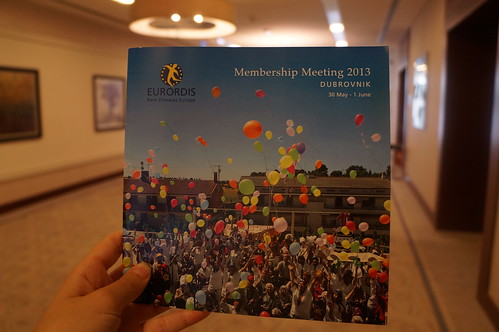
By Danijela Szili.
EURORDIS is a non-governmental patient-driven alliance of patient organisations representing 585 rare disease patient organisations in 54 countries covering over 4000 diseases. Every year EURORDIS organizes its Membership Meeting in a different European city. This is an occasion for patient representatives to gather and learn from each other.
The EURORDIS Membership Meeting 2013 took place in beautiful Dubrovnik, Croatia from 30 May – 1 June.
Over 200 participants from over 30 countries discussed issues ranging from funding for National Plans for Rare Diseases, off-label use of medicines, strategies and tools for improving patients’ access to orphan medicinal products, medicines, side effects & patient safety, registries, European reference networks & centres of expertise, specialized social services and new-born screening and genetic testing. The ambitious agenda demonstrates the complexity of issues facing the rare disease community. The presentations exposed each topic in detail and were followed by interesting panel discussions.

The EURORDIS General Assembly also was held during the Membership Meeting.
• Consult the programme: http://www.eurordis.org/sites/default/files/dubrovnik-2013.pdf
• View the presentations: http://www.eurordis.org/content/eurordis-membership-meeting-2013-presentations
• View the photos: http://www.flickr.com/photos/eurordis/sets/72157633983947672/
This meeting and my trip to Dubrovnik is something I was looking for eagerly. At the same time I was a bit afraid of how my first trip to Croatia after more then twenty years will look like. My best childhood memories were summers spent on the Dalmatian coast with my family. I was happy to be there again and hoped that no one would comment on my Croatian with Serbian accent and start attacking my Serbian background. But, surprisingly while being there no one from the natives did not even notice my accent. It is probably lost in the years of living abroad, in Hungary.
Dubrovnik is a magical city and I would very much like to visit it again. This time I was so busy attending sessions and meetings that I did not see much of it. Never the less it was enough to fall in love with this medieval jewel. It was difficult to leave the seaside I love so much.
I was happy to meet my old friends from the rare disease community again. This time I was lucky enough to meet some new ones also and hear interesting ideas about future projects and news from the fields I am involved in.
My program was very intensive and started with the Meeting of patient organizations from Croatia and neighboring countries, organized by the Croatian Alliance for Rare diseases. This meeting was in Croatian and I am very happy that I could be there, hear the overview about the work of the Croatian umbrella association and some interesting presentations and ideas from the member associations. Although all the countries from the ex Yugoslavia share similar problems after this meeting I got an impression that Croatia is at least one step before others and was impressed with the work Vlasta Zmazek has done as a president. This was a rare opportunity to meet rare disease parents and patient advocates from my ex home country, to speak in my own language and be understood. Unfortunately there is no official Rett Syndrome Association or Foundation in Croatia and although Rett representative from Croatia was informed about this event via email he was not present there. EURORDIS was able to offer 42 fellowships for this year’s Membership Meeting, including 30 for patient organization representatives from Croatia and surrounding countries so it is really a pity that I was the only Rett parent there from ex Yugoslavia.
I was very happy to meet a mom from Croatia (her boy has a cerebral palsy) who gave me very useful info about the AAC apps in Croatian. She did a great job involving IT University students in Zagreb in making augmentative communication apps without any cost for her association. This could be of great help for the Rett parents from ex Yugoslavia.
In the afternoon I attended Learning from Each Other Workshop which was in fact about Social Media Best Practices& Rare Connect
New features of RareConnect will be that not only moderators but all involved in a discussion will be getting notifications about new posts and that one new language, Japanese will be introduced this year.
Rett syndrome community has been present on Rare Connect for more then a year now.
Rett Syndrome on RareConnect:
https://www.rareconnect.org/en/community/rett-syndrome
Since its creation the Rett community has 181 members, 22 patient groups featured, 14 articles, 8 testimonials and 42 forum topics.
Data below is from the last 3 months – March 24th – June 24th
Who has visited the Rett Community over the past 3 months? – 1665 unique visitors
What do they do when they visit? – These visitors visit 2, 62 pages on average
These are the most visited pages of our community:
Top 10 countries with most visitors:
1. United States 408
2. Italy 203
3. France 127
4. Germany 115
5. Spain 102
6. United Kingdom 91
7. Canada 63
8. Netherlands 58
9. Australia 30
10. Switzerland 24
Please join us if you are still not a member of the Rett Community on RareConnect. If already a member we encourage you to post an update about your patient group, or your family on the community. You can also email us when you have a new event, document, or video to add (szilidanijela@gmail.com, thomasbertrandtrett@gmail.com).
On the EURORDIS Annual General Assembly held on the next day Activity Report 2012 was presented. This followed by the Financial Report 2012 & Auditor’s Report, Auditor’s Special Report on regulated conventions, Action Plan 2013 & Budget 2013, Call for a European Year of Rare Disease (2019), Candidates to the Board of Directors: Presentations, Resolutions vote & Board of Directors election, Q&A and Results of Resolutions vote & Board of Directors election.

The year 2019 was chosen since it will mark a turning point in the history of Rare Diseases as we will celebrate 20 years since the adoption of the EU Regulation on Orphan Medicinal Products, which has boosted orphan drug development; 10 years, since the Commission adopted its recommendation on Rare Diseases: Europe’s Challenges and the Council its Recommendation on an action in the field of rare diseases, making a common strategy for rare disease patients. It will also be the time to evaluate the progress made by the Health for Growth and Horizon 2020 EU Programmes and start operating in view of the new EU multi-annual financial framework 2020-2025.
In the afternoon I attended Rare Disease Patient Registries Workshop.
Rare Disease Patients Registries are key instruments for increasing knowledge on rare diseases, which makes EPIRARE: European Platform for Rare Disease Registries (www.epirare.eu) very important.
EPIRARE (European Platform for Rare Disease Registries) is a three-year project co-funded by the European Commission within the EU Program of Community Action in the field of Public Health. EPIRARE started officially on April 15, 2011. The adoption of the EU Council Recommendation on rare diseases (2009/872/CE), which recommends support of registers and databases for epidemiological purpose, is expected to result in a burst of initiatives for rare disease registration.
Specific objectives are:
1. Define the needs of the EU registries and databases on rare diseases
To define the state of the art of existing registries with reference to their legal basis; organizational and IT measures used; type of data collected; compliance with the rules on personal data protection; quality assurance; operational and financial support.
2. Identify key issues to prepare a legal basis
To assess the feasibility of an EU legal instrument to allow the integration of national information sources and the collation and exchange of data at the Community level in compliance with the EU Directive 45/96 and with other relevant provisions.
3. Agree on a Common data set and elaborate procedures for quality control
To define a minimum data set for all rare diseases; to define criteria for quality assessment of data, data sources and procedures in the registries.
4. Agree on the Register and Platform Scope, Governance and long-term sustainability
To define the scope, operation and governance model of the platform, balancing the interests of relevant stakeholders and ensuring long-term sustainability of the platform. To identify tools and other facilities to support the operation of platform users.
The project is organised in 8 Workpackages.
At this Workshop two EPIRARE surveys were presented: Professionals’ survey by Luciano Vittozzi and preliminary data analysis from the Patients’ survey by Monica Ensini. These two presentations were followed by very informative presentation by Ségoléne Aymé, EUCERD Chair on EUCERD Draft recommendations on registries and data collection for Rare Diseases and panel discussion.
Patients’ survey conducted by Eurordis was criticized because the questions very not clear and that is why some of the results, patients answers were very surprising. Rett syndrome parents also took part in it. The on-line survey, powered by SurveyMonkey, was proposed in 11 languages. Diseases most represented were: Williams syndrome, Behcet disease, Scleroderma, Duchenne muscular dystrophy, Cystic fibrosis and Rett syndrome. The abov- mentioned critics originated from the answers to the following two questions.
How should previously collected information be handled if a register closes? It should be:
Destroyed?, Stored indefinitely?, Stored for a limited time?, Made available to other registries or to the research community?
Almost 80 percent answered that it should be destroyed.
On the other hand to the question: “If a participant wishes to withdraw from a registry, what should happen to his/her data?”, the answer was to have his/her information anonymized for future research (irreversible destruction of participant’s identity).
Considering the importance of the registries for Rare Disease patents and in our case Rett research and the fact that in Europe we have Rett Syndrome Networked Database (https://www.rettdatabasenetwork.org) there is a need for us parents involved in the work of RSE to be involved in this subject and be more educated. Curently Oliviero del Oro and Jordi Serra are involved in the work of its governing board as observers.
The answer to the question: “Do you agree that the European Commission should propose legislation to uniformly regulate rare disease patient registers across Europe?”, is in 96% of the cases “yes”.
Important take home messages:
Don’t Stop Research on Rare Diseases!
Please sign the petition and spread the word; the link is on www.epirare.eu
As of 27 May we have reached 2406 signatures, but we aim at 10 000!
The new Draft Regulation on the General Data Protection, currently discussed in the EU Parliament, hinders the use of the small amount of RD data that are collected. It will dramatically delay health research and the improvement of health care of RD patients! This petition is supporting the amendments requested by EPIRARE, EURORDIS and many other organizations.
Further explanations and model e-mails in 9 languages on
http://www.epirare.eu/petition.html
DITA (Drug Information Transparency & Access) Task Force is the only remaining EURORDIS working group. It consists of volunteers and three members of the Eurordis stuff to support them.
– Anne-Mary Bodin, Unit assistant, 3 days/month
– Rob Camp, Consultant
– François Houyez, task force co-leader
DITA is open for new volunteer members. The only condition is that a patient representative attended Eurordis Summer School in Barcelona.
http://www.eurordis.org/content/eurordis-summer-school-patient-advocates
Eurordis has two members in the PCWP (Patients and Consumers Working Party) at the EMA (European Medicines Agency). www.ema.europa.eu
They are overloaded with very complex tasks and activities and DITA is formed in order to support their work. The reason why the work of EMA is so important for rare disease patient advocates is, among others, centralized procedure for granting new medicinal products from certain groups like orphan drugs marketing authorization (MA) for the whole EU. Assessment of the submitted application is done by CHMP (Committee for the Human Medicinal Products) at the EMA and upon their positive opinion recommendation is forwarded to EU Commission, who can then grant marketing authorisation for the new products for the whole EU territory. The EMA has no influence what so ever on the price and availability of the authorised orphan product in each member state.
DITA members were speakers at the meeting in Dubrovnik. Workshop Off –label use in Rare Diseases was moderated by Francois Houyez.
For many rare disease patients off-label (medicine prescribed for a use different from what is authorised on the label) use is the only way to get to some kind of drug therapy. This goes with lots of risks for the patients because the exact benefits and risks of the medicines taken off-label are not known due to the lack of studies and clinical trials. Rob Camp presented Results of the Pilot Survey on Off-label use conducted by Eurordis.
All interesting presentations that followed are on the Eurordis website given above and I would kindly recommend them.
The one I would like to highlight is about EU Directive on Pharmacovigilance and the role of patients’ organizations. As you probably all know the major change is the possibility for patients or their relatives to report the side effects of the medicines directly to their national portals on line. For more info check the Eurordis website: http://www.eurordis.org/pharmacovigilance
———
Save the date!
The 7th European Conference on Rare Diseases & Orphan Products (ECRD) will take place from 8 to 10 May 2014 at Andel’s Hotel Berlin, Germany.
For more information about ECRD 2014 Berlin, programme updates and registration, visit the official conference website: www.rare-diseases.eu
———
Save the date!
The next Epirare conference will be held in Rome.
RARE DISEASE AND ORPHAN DRUG REGISTRIES
2nd International Workshop
21-22 October 2013
Italian National Institute of Health – Viale Regina Elena, 299 – Rome (Italy)

